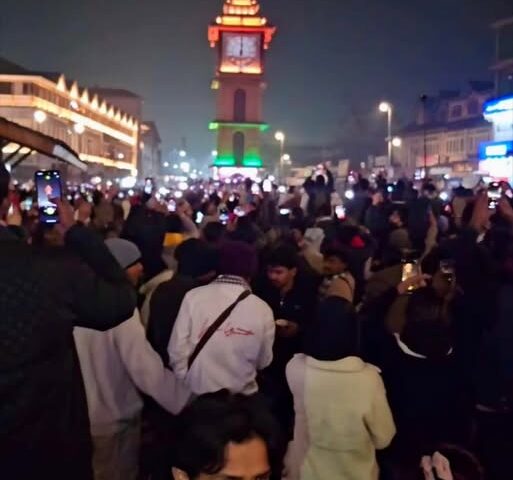Paradise Under Pressure: Kashmir’s Harsh 2025 Reality
By: Javid Amin | 05 Aug 2025
Kashmir — often described in poetry as “Paradise on Earth” — is today caught in a storm of reality. In 2025, the Valley’s economy did not just stumble, it collapsed under the combined weight of climate disasters, infrastructure bottlenecks, and policy blind spots.
The three economic pillars that sustain life here — tourism, trade, and horticulture — suffered crippling blows all at once. Families that once depended on apple orchards, bustling markets, and seasonal tourist flows are now staring at debt, despair, and displacement.
This is not just an economic report. It is a human story of how livelihoods, dreams, and everyday survival in Kashmir were tested — and in many cases, broken.
Climate Chaos: The Catalyst of Collapse
Flash Floods and Landslides Wreak Havoc
The late summer of 2025 was unlike any in recent memory. Relentless rains turned Kashmir’s mountain slopes into mudslides. The Jhelum River breached danger marks. Embankments cracked. Fields submerged.
Districts like Anantnag, Pulwama, and Baramulla witnessed flash floods that washed away bridges and inundated markets. The Srinagar city center saw knee-deep water, paralyzing life for days.
The immediate consequences were stark:
-
Highways blocked for over a week by landslides near Ramban and Banihal
-
Rail services suspended, cutting the Valley off from the rest of India
-
Markets flooded, with goods destroyed in Lal Chowk and Sopore mandis
-
Thousands evacuated, with relief camps overcrowded and under-equipped
This wasn’t just a natural disaster. It was a systemic failure to prepare, respond, and recover — exposing how fragile Kashmir’s economy is when weather turns extreme.
Trade Choked: When Highways Become Hostage
NH-44 Shutdown: Kashmir’s Lifeline Cut Off
If Kashmir has an economic lifeline, it is the Jammu–Srinagar National Highway (NH-44). Every apple crate, walnut sack, textile bale, and grocery truck travels this 270-km stretch. When it closes, Kashmir suffocates.
In 2025, landslides and sinking patches shut NH-44 for nearly a week. The result was devastating:
-
800+ fruit trucks stranded at Qazigund and Banihal
-
Losses touching ₹200 crore in just a few days
-
Spoilage rate exceeding 70% for perishable produce like Bagogosha pears and plums
In Delhi’s Azadpur Mandi, apple arrivals plummeted, triggering shortages. Traders in Mumbai and Bengaluru scrambled for alternatives. Back in Kashmir, growers sat helpless, watching their investments rot roadside.
📢 Voice from the Ground
“The highway is our lifeline. When it shuts, everything shuts.” — Bilal Lone, transporter, Baramulla
Horticulture in Distress: The Backbone Buckles
Apple Trade Suffers Historic Blow
If tourism is Kashmir’s seasonal face, horticulture is its backbone. Nearly 3 million people depend on it, and apples alone contribute 8% to J&K’s GDP. Yet in 2025, the sector collapsed.
At Sopore Fruit Mandi — Asia’s second-largest — the contrast was painful. A mandi that normally dispatches 150 trucks daily saw numbers fall below 20.
-
Apple prices crashed: American Red apples dropped from ₹600 to ₹400 per box.
-
Truckloads worth ₹15 lakh recovered barely ₹1–2 lakh in Delhi mandis.
-
Growers sank into debt, with no insurance or compensation mechanisms.
📢 Voice from the Ground
“We lost our entire harvest. No one came. No one paid. We just watched it rot.” — Bashir Ahmad Dar, orchardist, Shopian
Neglect of Horticulture Policy
Experts argue the crisis is not new, only magnified by floods. For decades, Kashmir’s horticulture has been underfunded and under-prioritized.
-
No comprehensive cold-chain storage across apple-producing belts
-
No rail-based freight corridors to bypass highway shutdowns
-
No climate-loss insurance schemes for growers
As Dr. Nazir Ahmad, agroeconomist in Sopore, points out:
“Tourism is important, no doubt. But horticulture feeds families across Kashmir year-round. Ignoring it is economic negligence.”
Tourism Collapse: From Record Highs to Empty Rooms
From Boom to Bust in a Single Season
In 2024, Kashmir celebrated record-breaking tourism: 2.36 crore arrivals, including 65,000 foreigners. But in 2025, the floods washed away the season:
-
Hotels in Pahalgam, Gulmarg, and Sonamarg reported occupancy below 20%.
-
Pilgrimage tourism — Amarnath Yatra, Vaishno Devi — suffered mass cancellations.
-
Homestay owners and tour operators were left refunding advance bookings.
📢 Voice from the Ground
“Tourists cancelled bookings. We refunded everything. Now we’re borrowing to survive.” — Shabnam Qureshi, homestay owner, Pahalgam
Fragility Exposed
Tourism, often branded as Kashmir’s “engine of growth,” showed its seasonal fragility. A single natural disaster wiped out the sector — leaving workers, guides, and small business owners penniless.
The Domino Effect: Who Suffers Most?
The collapse rippled far beyond orchards and hotels.
-
Small Traders: Saw local markets empty, shelves bare, and essentials overpriced.
-
Artisans: From papier-mâché workers to carpet weavers, orders dried up without tourists.
-
Daily Wage Earners: Porters, loaders, and drivers had no work — and no savings.
-
Women’s Cooperatives: Saffron and almond exports delayed, forcing defaults on microloans.
-
Youth Entrepreneurs: Logistics and hospitality startups collapsed before maturing.
The crisis wasn’t only about economics. It was about dignity, survival, and social stability.
Infrastructure and Policy: The Missing Links
Cold Storage Crisis
Despite producing over 20 lakh MT of apples annually, Kashmir has only a fraction of the required cold-storage capacity. Farmers are forced into distress sales at throwaway prices.
No Rail Freight Alternatives
When the highway shuts, Kashmir becomes an island economy. A dedicated Srinagar–Delhi rail freight corridor could have saved crores in 2025.
Policy Blind Spots
-
No emergency logistics plan for perishable produce
-
No compensation protocol for stranded goods
-
No climate-risk insurance for growers and traders
📢 Voice from the Ground
“Our mandi was empty. The orchards were full, but no trucks moved.” — Riyaz, Sopore trader
What Kashmir Needs Now
For Kashmir to recover, piecemeal fixes won’t do. It needs structural transformation:
-
Emergency Transport Corridors
-
Launch rail-based cargo routes from Srinagar to Delhi.
-
Experiment with drone-assisted deliveries for remote regions.
-
-
Horticulture Investment
-
Build cold storage units across Shopian, Pulwama, Anantnag.
-
Facilitate direct exports to Gulf & Europe to bypass middlemen.
-
-
Tourism Resilience
-
Invest in climate-proof hotels, roads, and flood-proof infrastructure.
-
Create seasonal insurance for operators, drivers, and homestays.
-
-
Disaster-Responsive Governance
-
Institutionalize relief audits and transparent compensation systems.
-
Develop community-led disaster planning with local participation.
-
Bottom-Line: A Valley at the Crossroads
Kashmir’s economic crisis of 2025 is a wake-up call. The Valley’s beauty, its orchards, its trade routes, and its bustling bazaars cannot survive on romantic slogans and short-term fixes.
-
Tourism may bring headlines, but it is fragile.
-
Horticulture sustains families, but remains neglected.
-
Trade routes remain vulnerable, holding the Valley hostage to landslides and policy apathy.
If Kashmir is to recover, it must rebuild its economy on resilience, infrastructure, and community strength. Only then can “Paradise on Earth” be more than poetry — it can be a place where people live with dignity, opportunity, and economic hope.




